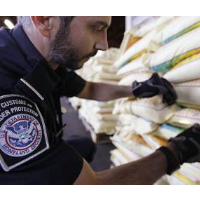FDA Proposes New Rules to Defend against “Food Terrorism”
 Food imports examined by Homeland Security agent (photo: Eric Risberg, AP)
Food imports examined by Homeland Security agent (photo: Eric Risberg, AP)
The Food and Drug Administration (FDA) has decided to get into the counterterrorism game by proposing new rules to prevent the poisoning of the nation’s food supply.
Food processors and manufacturers, including those based overseas that ship to the U.S., would be required to take action to secure products and ingredients from “intentional adulteration,” under the regulations.
Don Kraemer, deputy director of the FDA's Center for Food Safety and Applied Nutrition, says the changes are necessary because food-based terrorism “has happened on a small-scale, and we’ve certainly studied it since 9/11 to assess what the potential impacts might be and they can be catastrophic,” he told Harvest Public Media.
One example took place in 1984, when followers of cult leader Bhagwan Shree Rajneesh infected salad bars at eight restaurants with salmonella in The Dalles, Oregon. More than 700 people became sick from the attack.
The FDA’s focus is not on restaurants, but food processing and storage facilities. Places like dairy farms, which maintain large volumes of liquids, and large-scale bakeries where multiple ingredients are mixed together would have to abide by the changes.
One terrorism expert, Peter Chalk at the RAND Corporation, says the American food supply has vulnerabilities.
“A lot of food processing manufacturers don’t practice rigid biosecurity,” Chalk told Harvest Public Media. Many food suppliers don’t employ such basic protections as using surveillance cameras, locking up warehouses, and failing to conduct background checks on temporary workers, he said. “So actually introducing a contaminant -- salmonella, botulism, mercury -- into the food chain would not be particularly difficult.”
A 2002 U.S raid on an al-Qaeda warehouse in Afghanistan turned up documents detailing plans to attack American agriculture. That this hasn’t happened yet could be due to terrorists’ preference for launching an attack that has a more visually alarming, bloodier impact, theorized Chalk. But an assault on the nation’s agricultural infrastructure could be just as damaging, if not more so. A Homeland Security report that assessed a hypothetical scenario in which foot-and-mouth disease is released on American livestock concluded that the impact on the U.S. economy would exceed $50 billion.
-Noel Brinkerhoff, Danny Biederman
To Learn More:
Focused Mitigation Strategies to Protect Food Against Intentional Adulteration (Regulations.gov)
Could Our Food Supply be a Target for Terrorists? (by Luke Runyon, Harvest Public Media)
FDA Proposes Rules To Prevent Terror Attack on U.S. Food Supply (Homeland Security Newswire)
- Top Stories
- Unusual News
- Where is the Money Going?
- Controversies
- U.S. and the World
- Appointments and Resignations
- Latest News
- Trump to Stop Deportations If…
- Trump Denounces World Series
- What If China Invaded the United States?
- Donald Trump Has a Mental Health Problem and It Has a Name
- Trump Goes on Renaming Frenzy






Comments